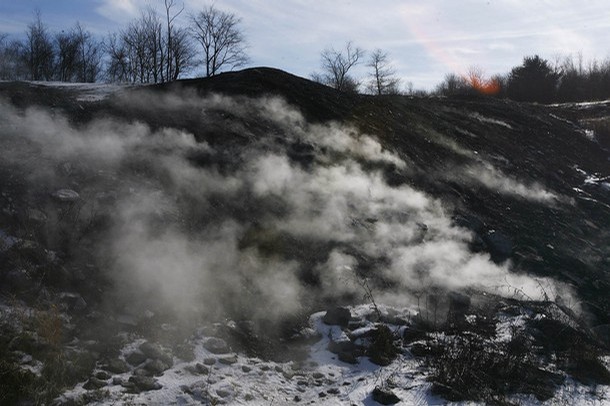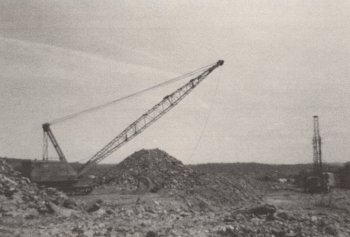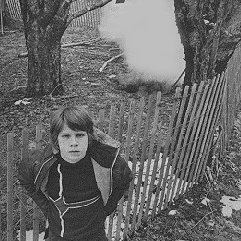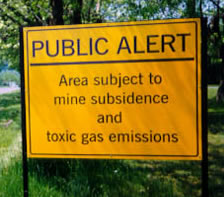All around [St. Ignatius Church in Centralia], smoke was hovering wispily off the ground, and just behind it, great volumes of smoke were billowing from the earth over a large area. I walked over and found myself on the lip of a vast cauldron, perhaps an acre in extent, which was emitting thick, cloudlike, pure white smoke—the kind of smoke you get from burning tires or old blankets. It was impossible to tell how deep the hole was. The ground felt warm and was loosely covered in a fine ash. —A description of Centralia from Bill Bryson's A Walk in the Woods (1998)

With only about a dozen residents and no zip code, Centralia, Columbia County is a veritable modern day ghost town. The smoke seeping from deep fissures in the earth, patches of burnt out vegetation, and the driveways leading to empty lots paint a macabre portrait of this once bustling small town. While mine fires are hardly rare in Pennsylvania—in 2007, there were estimated to be at least thirty burning in the state—Centralia stands alone as a poignant symbol of the devastation wrought by these disasters.
Since the mid-nineteenth century, Pennsylvania's rich bounty of coal has been formative in its history. Coal mining impacted the Commonwealth immensely on social, political, and economic levels. On the national stage, Pennsylvania's abundance of coal pushed forward the process of industrialization. In the words of historian Michael Zuckerman, "without Pennsylvania, industrialization in America would have been far more halting than it was, and the national economy might well have remained primarily agricultural." Despite the profitability of mining ventures, the mines themselves were often characterized by horrific working conditions, where the potential for catastrophe was always real.
The Borough of Centralia was founded in 1866 as a community for miners and other employees of the Locust Mountain Coal and Iron Company, which had recently opened several mines in the anthracite fields nearby. In many ways, Centralia was a quintessential Pennsylvania mining town. The town's levels of prosperity and population frequently shifted in response to the unpredictable market for coal. Miners worked long days, performing hazardous tasks for paltry wages. Local communities were forged through the bonds of ethnic and religious affiliation.
By the 1960's, Centralia had already been on a slow economic decline for several decades. The anthracite region of northeastern and central Pennsylvania contains 95% of anthracite coal in the United States. The market for this type of coal and for coal in general peaked around World War I and experienced a steady drop-off thereafter. The population of Centralia was less than 1,500 in the 1960 Census compared with over 2,500 in the 1890 Census. The mine fire was a sudden and dramatic disaster piled onto the advancing economic disaster throughout the region.
The fire began in May 1962 at an abandoned strip mine that was being used as a garbage dump. Although there is still disagreement regarding how the dump fire started, it is widely acknowledged that this fire soon spread to a coal seam underground. While regulations required that all entrances into closed mines be filled with incombustible material, one fifteen foot hole was not previously noticed and had been left open.

The extensive, interconnected mining tunnels beneath Centralia, still rich with anthracite, provided an ideal environment for a mine fire and enabled its rapid spread. Early attempts to extinguish the fire in the summer of 1962 failed, mostly due to lack of money. In several cases, an additional commitment of $10,000-$20,000 may have been enough to put out the fire.
Since a good deal of money was already being spent on mine fires elsewhere in Pennsylvania and because it was impossible to predict how quickly the fire in Centralia would spread, there was no real sense of urgency at this time. On August 9, 1962, mines near Centralia were permanently closed when carbon monoxide, a byproduct of the fire, was detected underground.
Most residents decided to stay in the immediate aftermath of the fire and through the attempts to extinguish it over the next two decades. Since the network of mines ran underneath the town, it was only a matter of time before noxious gases and the danger of sudden ground collapse—known as subsidence—became a part of everyday life in Centralia.
In his 1986 book about Centralia, Unseen Danger, local journalist David DeKok recounts the situation for those living closest to the fire site in Centralia: "burning eyes, the taste of sulfur, and an acrid odor accompanied by headaches, lassitude, and respiratory troubles." A 1984 study conducted by Pennsylvania State University's Milton S. Hershey Medical Center confirmed that the residents of Centralia suffered a greater incidence of health problems than those living in neighboring towns.
The conditions in Centralia were getting worse, but faced with the option of staying or starting over from scratch, many hoped that the fire would burn out or be extinguished, and many did not have the means to relocate regardless.

In 1981, Centralia garnered the attention of the national media after the ground gave way beneath twelve-year-old Todd Dombowksi. Dombowski was able to grasp a tree root to avoid falling down the eighty foot hole that had opened up beneath him. His cousin heard his cries for help and pulled him to safety. He was extremely lucky to live through the ordeal. The treacherous fall, the fumes, or the heat from the fire could have killed him.
The media coverage that this incident brought to the situation in Centralia led, ultimately, to national efforts to deal with the fire. In 1984, with the cost of putting out the fire estimated at $660 million, Congress passed a bill that would provide $42 million to relocate, on a voluntary basis, the families that wished to leave Centralia. Some have estimated that $50,000 may have been enough money to end the fire in 1962.

As the relocation plan remained voluntary, the choice between abandoning a lifelong home and enduring risks to health and personal safety divided the community. While about half of Centralia's residents initially volunteered for relocation, there has been a slow matriculation out of the town ever since. In 1992, the State Government declared eminent domain, meaning that families that had lived there for generations were considered squatters. Several families still remain in the area, as the state has yet to forcibly evict anyone.
The story of this town remains an object of fascination and inspiration in literature and film. Poet Leonard Kress wrote The Centralia Mine Fire (1987), a book of poetry containing poems inspired by the disaster. In his best-selling book, A Walk in the Woods, Bill Bryson pays a visit to Centralia, which he calls, "the strangest, saddest town I believe I have ever seen." James Finney Boylan's first novel, The Planets (1991) is set in Centralia, as is its sequel The Constellations (1994). In 1998, Kutztown University Professor Deryl B. Johnson penned the play Centralia about the town. The set of the 2006 horror film Silent Hill was also partially inspired by Centralia. Numerous other articles and documentaries have examined the meaning of this tragedy and its legacy.
The town rises slowly from the burning ground.
Watch the vacant homes, unsellable now,
freshly blanched with strips of siding, the crowned
churches, their Babel of tribal Masses below the show
of sunlight on gold and copper; and the sky, split
by brittle steeples. It is little grown
from the company town -- patchwork village by the pit
with omnipresent monument, the Breaker, flown
like a buttress against the black mountain —
this the shrine of the Holy Order of Anthracite.
Though odors of bottom damp and methane
no longer reek into the streets and ignite,
the underground tunnels burn, and each vein
of coal, potential fuse, leads to another domain.
-An excerpt from "The Centralia Mine Fire," which appears in Leonard Kress's first book of poetry, The Centralia Mine Fire (1987)
Sources:
- Clines, Francis X. "For 40 Years and Counting, Fire Down Below and Dogged Persistence Above." New York Times 23 Jul. 2002: A10.
- DeKok, David. Unseen Danger: A Tragedy of People, Government, and the Centralia Mine Fire. Philadelphia: University of Pennsylvania Press, 1986.
- Dublin, Thomas and Walter Licht. The Face of Decline: The Pennsylvania Anthracite Region in the Twentieth Century. Ithaca, NY: Cornell University Press, 2005.
- Hopey, Don. "$1 Billion to Help Clean Up Mine Sites Across Pa." Pittsburgh Post-Gazette 4 Jan. 2007: B1.
- Krajick, Kevin. "Fire in the Hole." Smithsonian Magazine May 2005. 52+.
- Kroll-Smith, J. Stephen and Stephen Robert Couch. The Real Disaster is Above Ground: A Mine Fire and Social Conflict. Lexington, KY: UP of Kentucky, 1990.
- "Poor Health Linked to Blaze in Centralia." New York Times 7 Feb. 1986: A12.
- Quigley, Joan. The Day the Earth Caved In: An American Mining Tragedy. New York: Random House, 2007.
- Schogol, Mark. "As Centralia's Fires Smolder, Residents Hang On." Philadelphia Inquirer 18 Mar. 2001: A01.
- Zuckerman, Michael. "The Making and Unmaking of the Pennsylvania Empire." Pennsylvania: A History of the Commonwealth. Ed. Randall M. Miller and William Pencak. University Park, PA: The Pennsylvania State University Press, 2002. 371-385.
